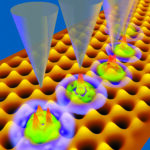Quantum entanglement is a phenomenon where two or more particles can be connected in such a way that the state of one particle is instantly correlated with the state of the other, even if separated by a large distance.

Bell’s theorem is a result in quantum physics that shows the mathematical incompatibility between the predictions of quantum mechanics and the idea that physical properties have pre-existing values (known as “local realism”). The theorem was demonstrated experimentally, and the results showed that quantum entanglement can indeed lead to statistical correlations that cannot be explained by local realism.
In simple terms, quantum entanglement and Bell’s theorem show that particles can be connected in a mysterious way, such that the state of one particle is instantly connected to the state of the other, no matter the distance between them, and that this phenomenon cannot be explained by the classical idea that properties of particles exist independently and beforehand.
Bell’s theorem proved quantum entanglement by showing that the predictions of quantum mechanics are incompatible with the concept of local realism, which assumes that physical properties of particles exist independently and have definite values prior to measurement.
Bell’s theorem provides a set of mathematical inequalities that describe the correlation between measurements of entangled particles. These inequalities can be tested experimentally by measuring the correlation between entangled particles under different settings. If the predictions of quantum mechanics are correct, then the experimental results should violate the inequalities described by Bell’s theorem.
In many experiments, the results indeed violated the inequalities described by Bell’s theorem, providing strong evidence for quantum entanglement and against local realism. These results confirmed that the correlation between entangled particles cannot be explained by any local mechanism and that the state of one particle is instantly correlated with the state of the other, regardless of the distance between them.
In short, Bell’s theorem provides experimental proof of quantum entanglement by showing that the correlation between entangled particles cannot be explained by the classical idea of local realism.





